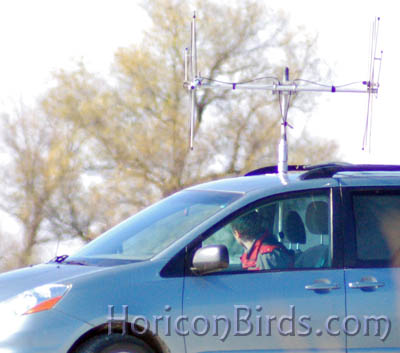
|
|
Horicon Birds home page
Contact HoriconBirds.com
Are you a lost birdie?
Horicon Marsh information
Bird watchers report it!
Passenger pigeon sightings
Where can I find some of these prints locally?:
Sponsors

VeggieCooking.com
The classic vegan cookbook
by Pam Rotella!
|
|
Horicon's Lost Whooping Crane
by Pam Rotella
November 2011
HoriconBirds.com
HORICON MARSH, WISCONSIN - On Saturday, October 29th, I went to Horicon Marsh to ask about the status of Horicon's first whooping crane release. This year, for the first time, the International Crane Foundation was using Horicon as one of its nesting sites -- Necedah wasn't working out very well, with its swarming black fly problem. Whooping cranes are one of the most endangered species on the planet, and the ICF has been trying to bring them back from the brink of extinction by releasing captive-bred birds into the wild.
Birds thrive at Horicon, including a good number of sandhill cranes. I was glad to hear that ICF was finally warming to the idea of a whooping crane flock at Horicon, and not just because photographers will have better access to the birds there. I truly believe that whooping cranes will also thrive at Horicon, just like the sandhill cranes and other water birds who nest there.
I asked about the whooping cranes at the visitor's center, and was told that one of the eight cranes released from Horicon had separated from the group.* They thought that the lone crane may still be in the area, and were hoping that the bird would follow the remaining sandhills on their migration south this year. Unlike grown chicks trained to migrate with an ultra light aircraft in past years, ICF had planned to allow this year's flock to be guided by Horicon's migrating sandhill crane population.
 Of course, hearing that was enough to make me look for the lost crane for a few hours. I did see a van with an antenna on its roof, sitting along the edge of a dirt road in the marsh, and asked the man inside if he was looking for the lost crane. He said yes. Then I asked if the whooping crane hung out with sandhill cranes. He said yes again, and so I told him where I'd seen or heard sandhills in the area. Like it or not, all whooping cranes released into the wild have tracking devices on them. They're so endangered that biologists follow and document the birds as much as possible.
Of course, hearing that was enough to make me look for the lost crane for a few hours. I did see a van with an antenna on its roof, sitting along the edge of a dirt road in the marsh, and asked the man inside if he was looking for the lost crane. He said yes. Then I asked if the whooping crane hung out with sandhill cranes. He said yes again, and so I told him where I'd seen or heard sandhills in the area. Like it or not, all whooping cranes released into the wild have tracking devices on them. They're so endangered that biologists follow and document the birds as much as possible.
Sometime between 2:30 and 3 p.m., I saw a small group of sandhill cranes flying out of the marsh in an area that usually has dozens of great egrets fishing together. Earlier that day, I'd heard what sounded like a large group of sandhills in the area, and thought that I'd heard a lone whooping crane call a couple of times, too. Sandhill calls are very pretty and ancient-sounding. I love hearing them, green herons too. Whooping cranes have a different, louder call, somewhat like certain geese calls but not exactly the same. I was hoping that I hadn't confused a whooping crane call with other water fowl who have similar-sounding calls.

|
|
As soon as I saw sandhill cranes flying out of the marsh, I decided to use my latest camera lens (cheap and awful yet very high zoom) to document them. They looked like sandhills from the ground, but I was hoping to enlarge the photos later to be sure. It's easy to identify cranes in the air vs. herons, even the white herons known as great egrets. Herons tuck their necks while flying, and so their heads are up against their bodies. Cranes don't, their necks are extended all the way out in front. Also, whooping cranes have red on the top of their heads, and black markings on their faces and wing tips -- it would be easy to differentiate them from the large number of great egrets who make the marsh their summer home. I noticed a few great egrets in the marsh that day, but not many. Normally their numbers are huge during the summer, and so I assumed that most egrets had already flown south for the season.
Whooping cranes can be confused with sandhill cranes, however, if the camera zoom isn't high enough to differentiate facial color. Many sandhills are gray this time of year -- they've already lost their brown summer camouflage. Some are even a light enough shade of gray to appear nearly white from the ground. Sandhill crane wing tips are also dark while in flight, similar to whooping cranes' black wing tips. Yet the face will always identify the species if it can be seen, as sandhills don't have black markings on their faces and whooping cranes do.
After the first few sandhills flew out of the old egret fishing grounds, another small group of cranes followed, and then another. I continued photographing cranes until 2:52 p.m. By that time, no crane groups had flown out of the marsh for a few minutes. I didn't know whether this was a part of the cranes' migration south, or the birds' normal movements just before migration. Birds fly their grown chicks around quite a lot at the end of summer, just before migration, to hunt for food but also to build strength and stamina in their chicks for the long journey south.
I couldn't wait to take the photos home, to enlarge them and look for the lonely whooping crane. Using the naked eye, most of the birds were too high in the air to decide whether they were whooping cranes or sandhills, but the high-powered zoom lens would help show their markings on a computer later.
When I went through the photos that night, they appeared to show 131 individual cranes -- quite a large number for cranes flying together. But they were all sandhills. There were maybe a dozen birds where the photos were too blurred or overexposed to identify the species for sure, but the gist of it is that I didn't find one whooping crane in my pictures. I didn't even find one "maybe, maybe not" bird to report. I did see one possibility in a photo of the old egret fishing area, something that looked like a grainy white bird with red on the top of its head and black near the water, but it was breaking into pixels and I've learned through the years that you can't trust images with resolution so poor.
Even after the good fortune of seeing 130+ cranes fly past me that day, the whooping crane eluded me. That was a slight disappointment, but I'd already had incredible luck in finding a large flock of sandhills where I could look for the rare bird. Before that day, I'd never seen more than a few cranes at a time, anywhere -- not even at Horicon Marsh.
UPDATE: Horicon posted on its Facebook page Monday, November 14th, that the lone whooping crane has been found in Rock County, WI -- in the area of Janesville and the Illinois border, although he's alone and it's unclear whether he'll find his way to livable winter grounds. But at least he's heading in the right direction... so far.
-------------------------
*Correction: Interviews with Kate Fitzwilliams of the International Crane Foundation on 26 January 2012 and Joe Duff of Operation Migration on 10 February 2012 confirmed that the "lost whooping crane" was from the whooping crane flock released at White River Marsh in Wisconsin and not Horicon Marsh. The interview with Joe Duff gives the most detail on the situation.
All original content including photographs © 2011 by Pam Rotella.
|
|